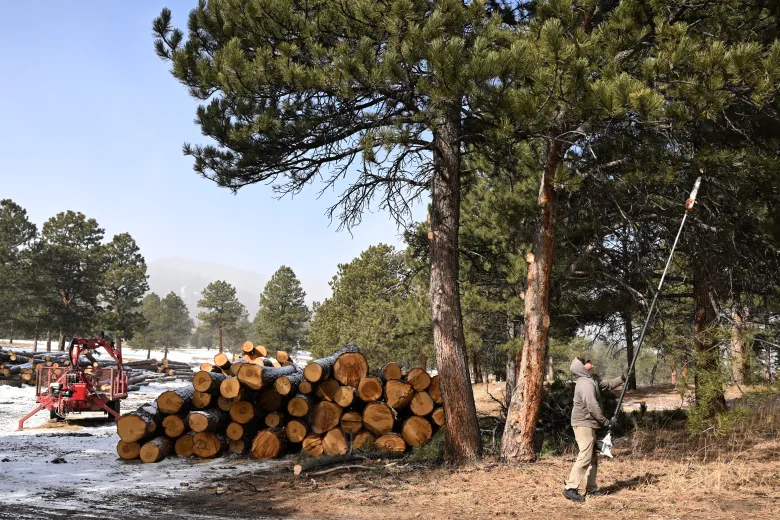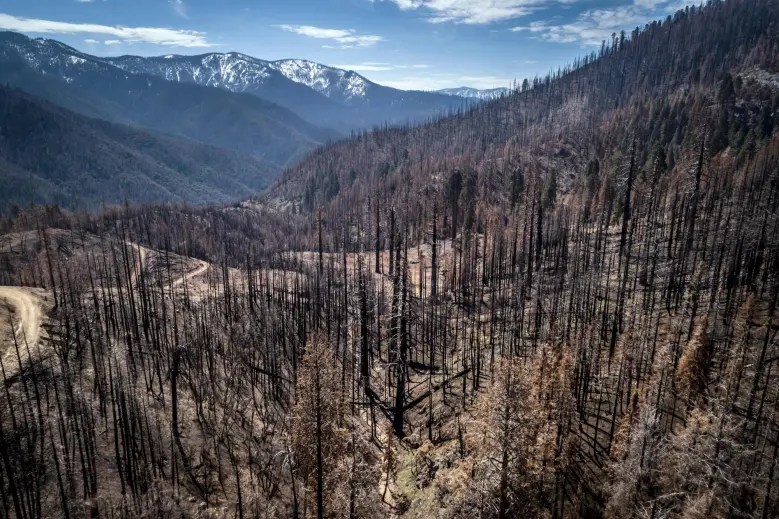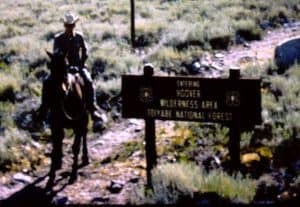
For some reason, there is a tendency in some outlets to talk about the Jefferson County controversy about fuel treatment in some open spaces, and pivot from there to the national debate about federal lands. it’s interesting to see how different reporters cover it. Apologies for this being so long, but I got very interested in the different takes on the same subject, as well as the omnipresence in these stories of a certain Californian.
Here’s the most recent by the Denver Post:
Tagline:
Logging opponent describes “complete shock and horror” at the sight of felled trees
Evergreen resident JoAnn Hackos, who also serves as a board member with the Evergreen Audubon chapter, said Jefferson County is targeting too many mature trees.
“I’ve seen truckloads of large, old-growth trees being driven away from our neighborhood parks,” Hackos said. “There is lots of money to be made in selling big trees, but it irreparably damages the forest.”
The county, she said, is using a technique called mastication, which essentially chops up treated areas into mulch. Hackos said the practice disrupts the soil and damages roots.
*******
Chad Hanson, forest and fire ecologist with the John Muir Project in Big Bear Lake, Calif., said Jefferson County “is doing everything wrong.”
“Removing mature trees increases wildfire spread and severity,” he said. “When they do these logging projects under the guise of thinning, that reduces the cooling shade of the canopy. Denser forests do not burn more intensely.”
**********
But Germaine said it’s a misnomer to call the ponderosas that are being cut old-growth trees, a term that evokes more of an emotional response.
“Ponderosa pine trees only begin to take on old-growth characteristics between 200 to 300 years of age, and they may live to 400 to 500 years,” he said. “Some of the trees we are cutting are large, and some are approaching 125 years in age, but none are old-growth.”
And the notion that the county is making a windfall from timber sales resulting from the felling is simply untrue, Germaine said.
“We hire local small business people to do most of our forest thinning. A lot of the material is ground up and spread around on-site because it has no market value,” he said. “We hold firewood sales to provide wood to local residents, and the county does not profit from any of this.”
Jefferson County pays contractors about $3,500 an acre for thinning, Germaine said.
Steve Germaine is the Natural Resources Supervisor for Jefferson County.
Here’s another Denver Post article.
The government faces opposition from forest lovers and environmental advocates who contend logging contractors operating with minimal oversight often mow down trees — rather than thinning — converting forests to grasslands, which the opponents argue could actually accelerate wind-driven fire. They accuse federal authorities of short-circuiting legally required environmental impact reviews. They favor “fire-wise” home safety as a smarter way to shave wildfire risks.
The argument comes down to ecological nuance and costs, which range from $500 to $7,000 an acre. It can be more feasible for loggers to cut broadly across an acre or more, rather than thinning that sometimes requires hiking on steep and hard-to-reach terrain, lugging chainsaws to remove trees selectively and optimizing spacing and species diversity.
There are two claims we usually don’t see.. that contractors don’t follow requirements and that feds short-circuit environmental reviews. It would be handy to have a quote from a person here, who could later be asked about specifics.
Fury over forest cutting intensified this summer and a grassroots Eco-Integrity Alliance deployed a billboard in central Denver urging President Biden and Colorado’s senators to “stop wasting $3 billion” for logging national forests.
Here’s the link to Eco-Integrity Alliance. It appears to be an alliance of groups including:
And I suppose a billboard costs some bucks, so there must be some funding associated with these groups.
What’s interesting about the Finley piece to me is he brought up Hanson as an advocate, not as the voice of science.
********
Here’s a Westword article. Westword is one of those independent papers you usually see in newstands in coffee shops in cities.. lots of culture and marijuana ads.
First the article talks about how Jeffco Open Space decided to do the project, including the mapping by Colorado Forest Restoration Institute of CSU and a verbal description of the rationale.
As JCOS implements forest-thinning projects, it tries to cut younger trees out of areas that have more trees per acre than what it estimates would have been there without historic fire suppression.
Sound familiar.. a la East Side screens?
Not all forests fit that mold, though, including those populated by ponderosa pines, points out Chad Hanson, practicing ecologist and director of the John Muir Project, which works to improve ecological management of public forests.
“The science strongly contradicts that narrative,” he says. “This is true for forests all across the West. This is true in the Colorado Front Range. … Everywhere scientists have looked at this, we’ve found the same thing: that historical forests were much denser overall than the U.S. Forest Service, or some state agencies that are involved in logging, have told the public they were.”
An expert person on the ground says “our forests are like this’ to Chad saying “the science says that many are not”. I think the question is simply “is this true of the forest we are working int?”
Schlossberg’s (he of the Steering Committee of the Eco-Integrity Alliance- sf) concerns come not only from the lack of scientific considerations in the forest-thinning plan, but also from the age of some of the downed trees. According to Germaine, the department doesn’t remove trees that are technically considered “old growth.” Those trees provide habitat for small mammals and birds and, if they are over 150 years old, were likely around before European intervention in American forests. It’s important to eliminate younger trees to keep the forest healthy, he contends.
“We don’t get a lot of water here on the east side of the Rocky Mountains, so when those trees are too crowded, they’re competing,” Germaine says.
According to Brett Wolk, assistant director of CSU’s Colorado Forest Restoration Institute, ponderosa pine tree systems take centuries to develop, and the trees can live for 500 years.
Schlossberg still takes issue with the idea that cutting down trees that have lived for a century is the answer, especially when it comes to the ponderosa pine.
“Why is it that ponderosa pine can grow that old?” he asks. “The answer is because they’re fire-resistant trees.”
***
“The notion that removing trees from the forest will curb fire has been soundly discredited,” Hanson says. “Wildfires are driven mostly by weather and climate, and therefore also by climate change. In drought years, you get the ignition, and you get hot, dry, windy conditions. Those are conditions for fires. It’s not mainly about forest density.”
In forest fires, trees like the ponderosa pine are rarely consumed; removing them doesn’t change fire intensity because they don’t contribute combustible materials. A study of California forest fires showed that even large wildfires consumed only about 2 percent of tree biomass.
*************
Hanson warned of emerging “sterilized landscapes” where forests once stood around cities.
The cited paper is by Harmon, Hanson and DellaSala (he who reviewed the Proforestation paper we discussed). It’s perfectly OK to be against commercial logging. It’s when you claim that “the science” says something and it turns out that we can find plenty of scientists who don’t agree. To reporters: anytime someone says “the science says this, ask them “are there any scientists who disagree with you?” and interview them.
They cannot go toe-to-toe with us on the scientific evidence,” he says. “Every time they try, they lose, so now, in desperation, they’re hitting below the belt, and they’re going personal and engaging in character assassination.”
Hanson believes that the logging industry relies on people buying into a positive narrative around cutting down trees, so it lobbies Congress to support forest-thinning management to keep that narrative alive. That lobbying trickles down to local forest management, he adds.
Or maybe other scientists can go toe-to-toe, and have in the 10 Common Questions paper. This is where some skepticism by the reporter might have paid off.
Here’s a link to a Colorado Sun story from last September. The Colorado Sun is a journalist-owned independent news outlet.
Again, Schlossberg
“What’s happening is we’re using the public lands as the sacrifice zones. We don’t think any of this tree cutting should be happening on public lands,” Schlossberg said. “It’s not justified scientifically or ecologically.”
A quote from Denver Mountain Parks.
The portions of Flying J that have raised the most public ire are actually controlled by Denver’s mountain park system, which cooperates with Jeffco when they have adjacent land.
“We got the short end of the stick at Flying J,” said Andy Perri, a Denver Mountain Parks program manager for forestry and natural resources. “We were dealt a very unhealthy forest on our two sections.”
Thick lodgepole stands on Denver’s portion of the property were plagued by beetles and dwarf mistletoe, which grows in the canopy and effectively places a tinderbox high in the forest. So Denver simply had to remove more, creating the shorn-land look that riled many visitors.
***********
“We try our best to contact neighbors, but it’s just me and two others in our program,” Perri said. Reaction ranges from extremely upset to extremely grateful, he added. “I try my best to explain the science — and we’re not here to sell timber, our wood is basically worth nothing.”
If a loud voice falls in the forest, does anyone hear?
Hannah Brenkert-Smith watched some of the same thinning vs. perception dynamic play out during a 2,460-acre cutting program on Arapaho-Roosevelt National Forest lands around Nederland. The plan included a public conflict-resolution process, which Brenkert-Smith later studied from her position in the Environment & Society Program at the University of Colorado’s Institute of Behavioral Science.
“What we found is that the people who are in opposition were actually in the minority,” Brenkert-Smith said. “They’re just really vocal and well organized, and they get a lot of attention.”
Forest managers the researchers worked with were often braced for much more overwhelming opposition that never really materialized, Brenkert-Smith said.
“So one of the things that I think is really important is not to assume what the public is going to think. And also not to let loud voices shape the narrative,” she said. “You actually have to go out and find out what people think, and not just the people who have the time and the motivation to show up at everything, and to write all the letters and to harness their social capital, but the silent majority who tends to be supportive.”
*********
This story gets points for including local scientists, and a social scientist.





